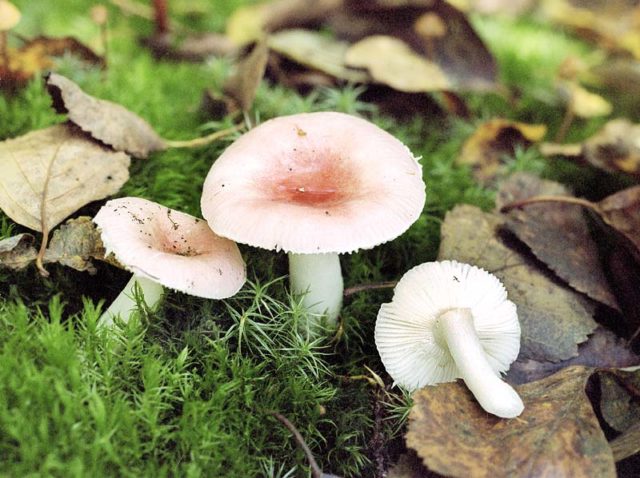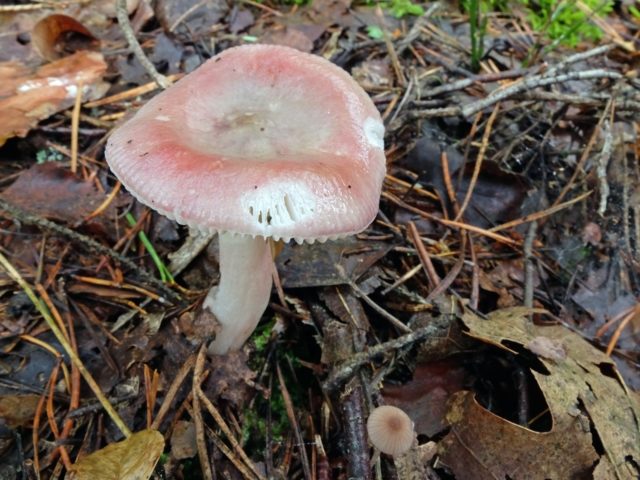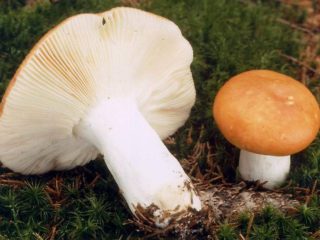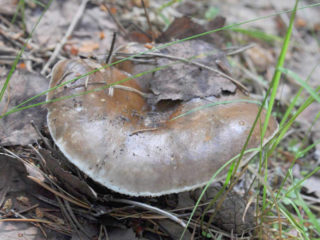Content
Turkish russula often ends up in mushroom pickers' baskets. This is an edible and even useful species, the main thing is not to confuse it with its poisonous counterparts.
Where do Turkish Russulas grow?
Turkish russula (lat. Russula turci) grows mainly in coniferous forests, mainly together with spruce and fir. Widely distributed in Europe. It also has other names - Merrilla, Brick, Blue. Grows singly or forms small groups. You can see it from mid-July to mid-autumn.
What do Turkish russulas look like?
The cap has a size from 3 to 10 cm and is purple-brown in color. In young people it is convex, but as it grows it straightens out, forming a small depression in the center. The skin is covered with a slimy coating and comes off easily when you try to remove it.
The pulp is dense and white in color; in older species it acquires a yellow tint. The bottom of russula consists of sparsely planted cream-colored plates. Reproduction occurs through spiny, ovoid spores.
The leg of the Turkish russula has the shape of a cylinder, in most cases it expands at the base. The pulp in this place is quite fragile. The color of the leg is white with a pink tint, and may be slightly yellowish.
Is it possible to eat Turkish russula?
Turkish russulas are considered edible. Some mushroom pickers do not collect them, opting for more noble species, however, there is no harm from them.
Taste qualities of mushroom
Turkish russula has a pleasant aroma and is not bitter. It tastes rather sweet, and the smell has fruity notes. There are several ways to prepare it for consumption.
Benefits and harm to the body
It’s not for nothing that Turkish russula ends up in mushroom pickers’ baskets. It has the following beneficial properties:
- contains vitamins PP and B2, which are necessary for the normal functioning of the body;
- has a beneficial effect on the gastrointestinal tract, even in the presence of diseases in this area;
- contains a small amount of calories, suitable for use in the fight against excess weight;
- quickly brings a feeling of fullness due to its high nutritional value;
- helps prevent blood thickening and blood clots;
- With the help of russula you can get a dairy product that is very useful for problems with the heart and blood vessels.
There is no harm from Turkish russula, but there are a number of contraindications for their use. These include:
- individual intolerance to mushrooms by the body;
- heart, kidney or liver problems;
- children under 12 years of age;
- During pregnancy and breastfeeding.
Adults are recommended to consume no more than 200 g of Turkish russula per day.
False doubles
The closest species to the Turkish one is the amethyst russula Russula amethystina. They are very similar, the main difference is a more pronounced spore network.
There are several types of russula, which, at first glance, can be confused; they are not suitable for consumption:
- Pink Kele - has a dark pink cap pressed in the center. Found among coniferous trees. The spores are beige in color and have a fruity odor. Considered inedible.
- Burning-acrid or emetic - its color is pink or bright red. The cap grows up to 5 cm, slightly pale at the edges. The leg is white, brittle. There is a pronounced bitterness in the taste. It is not eaten.
- Berezovaya - prefers swampy forests with deciduous trees, mainly birches. The cap is beige or cream in color and reaches 5 cm in diameter. The leg is light, shaped like a cylinder. The mushroom is very fragile and crumbles in your hands. Not recommended for consumption.
- Acute - an inedible mushroom with a dark purple cap. The plates on the lower part are narrow and light brown in color. Grows in spruce forests.
- Most graceful - the mushroom is fragile and brittle even in appearance. Prefers mixed or deciduous forests.The cap is pinkish or pale purple, the plates are often set and have a yellowish tint. They are not eaten.
All types of russula are similar to each other, so when collecting them you need to be especially careful.
The main thing is to know the main differences between edible specimens and poisonous ones:
- the dangerous mushroom often has a ring on the stem and a wavy fringe under the cap;
- at the base of the toadstools there is a film called volva; edible species do not have such a part in their structure;
- the leg of the safe species is thicker and smoother;
- the pulp of russula is denser than that of a poisonous mushroom, but at the same time fragile;
- The mushroom should be inspected for the presence of worms and traces of slugs - no one starts with dangerous ones;
- Russula with a greenish cap is most often confused with the pale toadstool, they can be distinguished by the lower part - in the poisonous species, the leg has gray or olive-colored scales.
These simple tips will help you distinguish a healthy mushroom from a dangerous one.
Collection rules
There are certain rules for collecting mushrooms, in particular Turkish russula:
- They are placed in baskets or an enamel bucket. Due to their fragility, bags, backpacks and packages are not suitable for collection. It is also important to place them on top, avoiding pressure from the contents of the basket.
- You can cut, break or uproot - the mycelium will not be damaged, it is located underground and is highly branched.
- Everything that was collected cannot be stored for long. Treatment is needed almost immediately after arriving from the forest.
Use
Turkish russula is consumed in various forms. Before any processing, it is recommended to cook the mushrooms for about 5 minutes, and then proceed to frying, salting or pickling. The water must be drained after cooking.
Turkish russula is often salted. After the necessary processing, the mushroom is placed in a pan with salt and garlic is added there. Then the preparations are allowed to stand for a day and currant leaves and onions are placed in them, and oil is poured. In this form, the mushrooms are packaged in jars and left for 30 days.
Several methods are used to marinate russula. They all differ in additional ingredients, but include the addition of vinegar.
There are a number of rules for cooking mushrooms:
- before the cooking process, they are sorted, washed and cleaned well;
- Pour water into the pan at the rate of 1 part mushrooms to 2 parts liquid;
- bring to a boil and reduce the flame;
- the resulting foam is removed, salt, pepper and bay leaf are added to the broth;
- cooking time from boiling water is 30 minutes;
- The liquid must be drained after all procedures.
Fried Turkish russula is no worse than other mushrooms, but this processing method is not so common. Most often the dish is eaten with a side dish.
Conclusion
Turkish russula takes pride of place among edible mushrooms. Its beneficial properties and various cooking options contribute to this. In addition, they are found more often than more noble species.

















